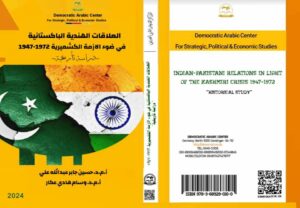العلاقات الهندية – الباكستانية في ضوء الازمة الكشميرية 1947-1972 دراسة تأريخية
Indian-Pakistani relations in light of the Kashmiri crisis 1947-1972 Historical study

تأليف : أ.م.د. حسين جاب عبد الله علي & أ.م.د. وسام هادي عكار
نسخة “pdf”-
العلاقات الهندية – الباكستانية في ضوء الازمة الكشميرية 1947-1972 دراسة تأريخية
الطبعة الأولى “2024″ –من كتاب: :- العلاقات الهندية – الباكستانية في ضوء الازمة الكشميرية 1947-1972 دراسة تأريخية
جميع حقوق الطبع محفوظة #المركز_الديمقراطي_العربي ولا يسمح بإعادة إصدار هذا الكتاب أو اي جزء منه أو تخزينه في نطاق إستعادة المعلومات أو نقله بأي شكل من الأشكال، دون إذن مسبق خطي من الناشر .
تقديم :-
تعد دولتا الهند والباكستان من دول العالم المتميزة لتاريخهما الطويل، ولأسهاماتهما الحضارية، وأعداد سكانهما الضخمة، فضلاً عن حجم مساحتيهما وموقعيهما الستراتيجي في قارة أسيا والروابط التي تربط بين الشعبين لكونهما يمثلان شعباً واحداً منذ فجر التاريخ حتى عام 1947م عندما صدر قانون استقلال الهند الذي أصدره البرلمان البريطاني إذ أنفصل المسلمون في دولة مستقلة لهم عرفت باسم (باكستان) فأن الدولتين قد شرعتا في إشهار السلاح بوجه إحداهما الأخرى بدلاً من الدخول في مفاوضات لحل المشاكل التي خلفها الاستعمار البريطاني بعد استقلالهما حتى غدا الصراع السمة البارزة التي وسمت علاقات الدوليتن.
وكانت الهند في زمن الاحتلال البريطاني تنقسم إلى قسمين أساسيين هما الإمارات والأقاليم، وبينما كانت الأقاليم تخضع للحكم المباشر للبريطانيين، كانت الإمارات حرة في أن تظل مستقلة أو تختار الانضمام إلى إحدى الدولتين الجديدتين مراعية في ذلك الوضع الجغرافي والعوامل الاقتصادية والستراتيجي، ثم رغبات الشعب، وعندما تم التصديق على القانون المذكور أوصى نائب الملك البريطاني لشؤون الهند (اللورد مونتابين) الولايات الهندية بأخذ هذه العوامل في الاعتبار وهو يعلم أن هناك استثناءات على أرض الواقع في شبه القارة الهندية.
كان من الواضح أن هذه الاستثناءات ستؤدي إلى نشوب النزاع بين سكان شبه القارة الهندية ليصبحوا فيما بعد فرقاء، وحدثت بالفعل عدة استثناءات، فقد كانت ولايتا حيدر أباد وجوناكاد الواقعتان بالقرب من باكستان وهما ذوات أغلبية هندوسية من السكان وأن كان حكامها يدينون بالإسلام.
ولعلّ أخطر هذه الاستثناءات ما كان في إقليم كشمير الذي كان يسكنه في الغالب مسلمين، بينما كان حاكمها من الهندوس، وبالرغم من ذلك، فضلاً عن العوامل الجغرافية والاستراتيجية، فإن المستعمر البريطاني أتفق مع حزب المؤتمر الهندي ذي الأغلبية الشعبية الكبيرة في الهند والذي يكاد يحتكر الحياة السياسية والحكم فيها منذ الاستقلال على ضم كشمير إلى الهند، وكان الهدف من وراء هذا واضحاً، وهو أن يصبح هذا الإقليم بؤرة للصراع المزمن بين الهند وباكستان.
Abstract
The countries of India and Pakistan are among the distinguished countries of the world due to their long history, their contributions to civilization, and their huge population numbers, as well as the size of their areas, their strategic location on the continent of Asia, and the ties that connect the two peoples because they represent one people since the dawn of history until 1947 AD when the Indian Independence Act was issued by Parliament. When the British separated the Muslims into an independent state known as (Pakistan), the two states began to take up arms against each other instead of entering into negotiations to solve the problems left by British colonialism after their independence, until the conflict became the prominent feature that characterized the relations of the two countries.
At the time of the British occupation, India was divided into two main parts: the emirates and the regions. While the regions were subject to the direct rule of the British, the emirates were free to remain independent or choose to join one of the two new states, taking into account the geographical situation, economic and strategic factors, and then the wishes of the people. The said law was ratified. The British Viceroy for India (Lord Montbane) recommended that the Indian states take these factors into consideration, knowing that there were exceptions on the ground in the Indian subcontinent.
It was clear that these exceptions would lead to the outbreak of conflict between the inhabitants of the Indian subcontinent, who would later become rivals, and several exceptions did occur. The states of Hyderabad and Junakad, located near Pakistan, had a Hindu majority population, even though their rulers believed in Islam.
Perhaps the most dangerous of these exceptions was in the Kashmir region, which was mostly inhabited by Muslims, while its ruler was Hindu. Despite this, in addition to geographical and strategic factors, the British colonialists agreed with the Indian Congress Party, which has a large popular majority in India and which almost monopolizes life. The policy and governance therein since independence decided to annex Kashmir to India, and the goal behind this was clear, which was for this region to become a hotbed of chronic conflict between India and Pakistan.
الناشر: المركـز الديمقراطي العربي للدراسات الاستراتيجية والسياسية والاقتصادية – ألمانيا – برلين
Democratic Arabic Center- Berlin – Germany





